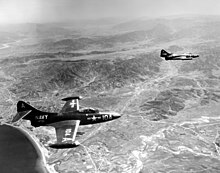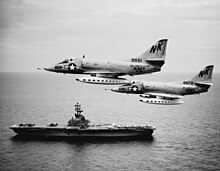Carrier Air Wing Fourteen
|
Carrier Air Wing Fourteen |
|
|---|---|

|
|
| active | July 1950 to 2013 |
| Country |
|
| Armed forces | United States Navy |
| Strength | approx. 2,500 people |
| Location | Naval Air Station Lemoore, CA |
| motto | Fortuna Favet Fortibus |
The Carrier Air Wing Fourteen (CVW-14) was a carrier squadron of the US Navy . It was installed at the NAS Miramar naval aviation base in California in July 1950 as part of the rearmament measures following the outbreak of the Korean War and decommissioned in 2013 due to budget cuts.
history
Originally, the squadron was set up as Carrier Air Group 101 (CVG-101) and consisted only of reserve squadrons, which had also been mobilized because of the Korean War . The reserve squadrons were equipped with Grumman F9F Panther, Vought F4U Corsair and Douglas AD Skyraider . The first mission on the carrier USS Boxer led to Korea in 1951. Another deployment followed in the Korean War 1952/53, this time on the Kearsarge . During this mission, CVG-101 was renamed CVG-14 on February 4, 1953 .
1954 followed a mission trip with the Randolph into the Mediterranean, then it went again for two trips with the porters Boxer and Hornet in the western Pacific. In 1958, the newly commissioned Ranger CVG-14 aircraft carrier took on board in Norfolk (Virginia) and reached its new home port of Alameda (California) on the way around Cape Horn . From then on, the squadron remained with the Pacific Fleet. Operational trips on the aircraft carriers Oriskany and Lexington followed by 1964 . On December 20, 1963, the name was changed to Carrier Air Wing Fourteen (CVW-14) .
In August 1964, CVW-14 was with the Constellation off Vietnam when the so-called Tonkin incident occurred. As a result, aircraft of the CVW-14 together with CVW-5 of the Ticonderoga attacked North Vietnamese speedboats and their bases on the 2nd and 4th / 5th. August 1964. This was the beginning of the actual Vietnam War . CVW-14 suffered the first casualties of the war in the attacks. On August 5, 1964, the Lieutenant RC Sather of Squadron VA-145 ( A-1H Skyraider ) and Everett Alvarez of Squadron VA-144 ( A-4C Skyhawk ) were shot down in attacks on the speedboat base of Hon Gay . Sather was fatally hit, Alvarez was taken prisoner and remained so until 1973. In total, CVW-14 made seven trips in the Vietnam War between 1964 and 1973 on the carriers Constellation , Ranger and Enterprise . 1973 CVW-14 was the first US Navy squadron to receive the Grumman F-14 Tomcat. These also flew missions over Vietnam in 1975, but only to protect the evacuations in the fall of South Vietnam ( Operation Frequent Wind ).
When the Enterprise had a longer stay in the shipyard in 1979, CVW-14 switched to the USS Coral Sea . During the first mission in 1979/80 to the Western Pacific and the Indian Ocean, the US Marine Corps fighter squadrons VMFA-323 and VMFA-531 were part of the squadron. This was the first time since World War II that squadrons of the Marines provided the fighter squadrons for a squadron of the US Navy. During this mission, Tehran was taken hostage, as a result of which the aircraft carriers Coral Sea and Nimitz were ordered to the Indian Ocean. The unsuccessful Operation Eagle Claw to rescue the hostages was started by these two carriers on April 24, 1980 . The CVW-14 aircraft had been specially provided with black, red and black identification stripes on the right wing for this operation.
Two more voyages on the Coral Sea followed before CVW-14 returned to the Constellation from 1985 to 1989 . In 1990 there was another switch to Independence . Used from this carrier, the squadron took part in Operation Desert Shield . In August 1991 Independence replaced the Midway as a porter stationed in Japan. The squadrons VF-21 and VF-154 with F-14 Tomcat and VS-21 with S-3 Viking switched to CVW-5 because these types of aircraft could not operate from the Midway . The remaining squadrons of CVW-14 switched to the Midway, from which they flew for a month until the carrier was decommissioned.
The next mission took place in 1994 from aboard the Carl Vinson . During this mission, CVW-14 took part in Operations Southern Watch and Desert Strike . When Operation Desert Strike aircraft flew of CVW-14 escorts for Boeing B-52 of the USAF . In 1998, the Naval Aviation Base NAS Lemoore (California) became the new home base of the CVW-14.
From 1998 to 2002 the squadron was deployed from the Abraham Lincoln , including in 2002 as part of Operation Northern Watch in the North Pacific. In the same year, the squadron was used in Operations Enduring Freedom in Afghanistan and Iraqi Freedom in Iraq. At the end of the mission, President George HW Bush visited the Abraham Lincoln . It was the first time a US president landed on an aircraft carrier in a carrier aircraft (an S-3B from VS-35 squadron) rather than in a helicopter. In 2004 he switched to John C. Stennis , in 2006 his last move to Ronald Reagan . The squadron was deployed in Operation Iraqi Freedom from both carriers . By 2012, five more trips on the Ronald Reagan followed . Originally, the CVW-14 was planned to be retired in 2012. However, this decision was reversed on March 20, 2012. However, all squadrons of the squadron switched to CVW-11 on board the USS Nimitz (CVN-68) , while CVW-2 was assigned to the Ronald Reagan . In 2013, CVW-14 was decommissioned due to budget cuts.
Final composition
The US Navy has had a fixed system for identifying squadrons or squadrons ( Visual Identification System for Naval Aircraft ) since 1945 . Initially, this consisted of geometric patterns on the tail unit. However, since these were difficult to remember or to describe, letters were introduced as early as June 1945 to distinguish the squadrons. CVG-101 / CVG-14 was assigned the letter "A". In 1957 the individual letters were replaced by doubles. In general, the squadrons of the Atlantic Fleet have an "A" as the first letter and those of the Pacific Fleet an "N". The Carrier Air Wing FOURTEEN was recognized by the code ( tail code ) NK . The individual squadrons of the squadron are numbered in increments of 100, the aircraft of the squadron commander ( Commander, Air Group (CAG) ) can be recognized by the tactical number ending in "00".
In 2012 CVW-14 was commanded by Captain Captain Hamlin A. Ortiz-Marty and his deputy was Captain Captain Kevin Mannix.
The following squadrons belong to the Carrier Air Wing Fourteen (CVW-14) last (September 2011):
| tactical number | Season | Aircraft type | Nickname | Radio callsign |
|---|---|---|---|---|
| 100 | VFA-154 | Boeing F / A-18F "Super Hornet" | Black Knights | Knight |
| 200 | VFA-147 | Boeing F / A-18E "Super Hornet" | Argonauts | Jason |
| 300 | VFA-146 | McDonnell Douglas F / A-18 C "Hornet" | Blue diamonds | xx |
| 400 | VMFA-323 | McDonnell Douglas F / A-18 C (N) "Hornet" | Death Rattlers | xx (USMC relay) |
| 500 | VAQ-139 | Grumman EA-6 B "Prowler" | Cougars | Cougar / War Cat |
| 600 | VAW-113 | Grumman E-2 C "Hawkeye 2000" | Black Eagles | Eagle / Black Eagle |
| 610 | HS-4 | Sikorsky SH-60F / HH-60H "Seahawk" | Black Knights | Fetch / Knight |
| xx | VRC-30 Det. 1 | Grumman C-2 A "Greyhound" | Providers | Password |
Web links
- Homepage of the CVW-14 (English)
- CVW-14 on GlobalSecurity.org (English)
- Site from Japan with comprehensive information on squadrons and squadrons (English)
- United States Naval Aviation 1910-1995. In: history.navy.mil. US Naval Institute, archived from the original on October 15, 2014 (English, table of contents; PDF documents for download).
Individual evidence
- ↑ http://www.gonavy.jp/CVG-CVG14f.html
- ↑ Archive link ( Memento of the original from March 21, 2008 in the Internet Archive ) Info: The archive link was inserted automatically and not yet checked. Please check the original and archive link according to the instructions and then remove this notice.
- ^ Robert L. Lawson (ed.): The History of US Naval Airpower . New York 1987. p. 200. ISBN 0-517-41481-3
- ↑ a b Archive link ( Memento of the original dated February 8, 2007 in the Internet Archive ) Info: The archive link was inserted automatically and not yet checked. Please check the original and archive link according to the instructions and then remove this notice.
- ^ Robert L. Lawson (ed.): The History of US Naval Airpower . New York 1987. pp. 208f. ISBN 0-517-41481-3
- ↑ http://www.navy.mil/search/display.asp?story_id=66193
- ↑ http://www.cvw11.navy.mil/
- ↑ http://www.cvw2.navy.mil/index.htm
- ↑ http://www.csfwp.navy.mil/
- ↑ http://www.history.navy.mil/avh-1910/APP23.PDF
- ↑ http://www.gonavy.jp/AIRPACf.html




